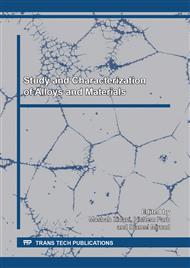p.81
p.88
p.101
p.111
p.118
p.125
p.141
p.147
p.161
Microstructure and Mechanical Properties of Chromium Carbide Coatings Deposited by Magnetron Sputtering Technique
Abstract:
From the hard and anti-corrosions coatings, we found the chromium carbides, these components were discovered by large studies; like thin films since years ago. They were pointed a good quality for the protection of steel, because of their thermal and mechanical properties for this reason, it was used in many fields for protection. Plus: their hardness and their important function in mechanical coatings. The aim of this work joins a study of the effect of the thermal treatment on mechanical and structural properties of the Cr/steel system. Thin films were deposited by cathodic magnetron sputtering on the steel substrates of 100C6, contain 1% wt of carbon. Samples were annealing in vacuum temperature interval between 700 to 1000 °C since 45 min, it forms the chromium carbides. Then pieces are characterising by X-ray diffraction, X-ray microanalysis and scanning electron microscopy. Mechanical properties are analysing by Vickers test. The X-ray diffraction analyse point the formation of the Cr7C3, Cr23C6 carbides at 900°C; they transformed to ternary carbides in a highest temperature, but the Cr3C2 doesn’t appear. The X-ray microanalysis shows the diffusion mechanism between the chromium film and the steel sample; from the variation of: Cr, Fe, C, O elements concentration with the change of annealing temperature. The variation of annealing temperature shows a clean improvement in mechanical and structural properties, like the adhesion and the micro-hardness.
Info:
Periodical:
Pages:
118-124
Citation:
Online since:
September 2019
Authors:
Keywords:
Price:
Сopyright:
© 2019 Trans Tech Publications Ltd. All Rights Reserved
Share:
Citation:


